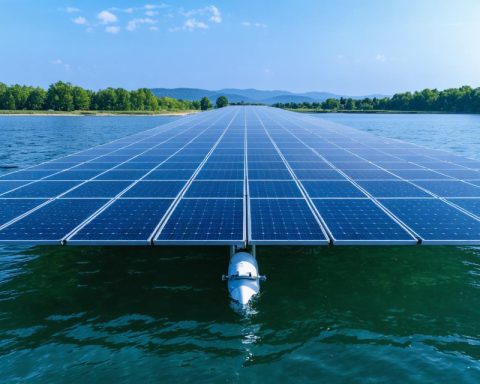- Wave power is emerging as a dependable and sustainable energy source, offering consistency and predictability unlike solar or wind energy.
- Scotland’s coasts serve as a testing ground for innovative wave energy converters (WECs) that harness oceanic energy to produce electricity with zero emissions.
- Waves possess a higher energy density, making them more efficient for power generation and valuable for reducing reliance on fossil fuels.
- Wave energy supports local economies by creating jobs in engineering, maintenance, and sustainable development.
- Technological innovations, such as Pelamis Wave Power and CETO, showcase diverse approaches to capturing wave energy while facing engineering challenges from hostile marine environments.
- The global wave energy sector is set for growth due to technological advancements and cost reductions, positioning it as a key player in the future energy landscape.
Roaring waves crash against cliffs with unrelenting force, a rhythm as old as time itself. This powerful display, a symphony of energy, has remained untapped for far too long. But that’s changing, as the world turns its gaze to wave power, a clean and dependable energy source set to revolutionize our quest for sustainability.
On the wild, scenic coasts of Scotland, engineers have embarked on a groundbreaking mission: harnessing the power of the ocean’s waves to fuel tomorrow’s world. Cut through the mist, and you’ll find the hulking structures of wave energy converters (WECs) standing sentry. These mechanical titans tirelessly capture the ocean’s energy, converting the kinetic force of waves into electricity, lighting the path to a greener future.
Why wave power? Unlike solar and wind energy, governed by daylight and wind conditions, waves never rest. As an energy source, they’re remarkably constant and predictable, ensuring a stable flow of power for coastal communities. Moreover, waves possess a higher energy density compared to both wind and solar, offering immense promise in terms of efficiency.
Crucially, wave power generates electricity with zero emissions, a significant stride in curbing our reliance on fossil fuels. Beyond its environmental benefits, wave energy bolsters local economies, creating jobs ranging from engineering to maintenance, and offering a sustainable lifeline to regions battered by climate change.
Innovation leads the charge in this watery frontier. For instance, Pelamis Wave Power’s cylindrical, snake-like devices flex with the movement of the waves, while CETO technology submerges beneath the waves, remaining out of sight and mind. These pioneering designs illustrate the rich tapestry of creativity driving marine energy technology.
However, challenges linger. The formidable ocean, as beautiful as it is fierce, presents engineering hurdles. Devices must withstand corrosive salt, extreme weather, and the corrosive power of these very waves they wish to harness. Yet, optimism sails high. The global wave energy sector is poised for robust growth, driven by advancing technology and plummeting costs.
The lesson emerges clear: As we look to power future generations, wave energy provides a potent, sustainable solution to one of our era’s defining challenges. Driven by unparalleled consistency and environmentally friendly credentials, the energy of our oceans offers a shining beacon of promise.
Seize the power of waves and picture a world where humanity harnesses nature’s vast energy. The tides are changing, propelling us towards a sustainable, energy-abundant horizon.
Ride the Wave: Unlocking the Future of Sustainable Energy with Wave Power
Wave Power: A New Frontier in Renewable Energy
Wave power is rapidly emerging as a crucial player in the global transition towards sustainable energy. Given its vast potential, it promises to transform not only electricity generation but also the economic and environmental landscape of coastal regions worldwide.
Unveiling the Potential of Wave Power
1. Unmatched Energy Density: Wave power stands out due to its high energy density. Waves can store about 1000 times more kinetic energy than wind, presenting an unparalleled opportunity for efficient electricity generation [IRENA].
2. Reliability and Predictability: Unlike solar or wind energy, wave energy benefits from a more consistent and predictable nature. Ocean waves can often be forecasted several days in advance, providing a significant advantage for grid management [EIA].
3. Job Creation and Economic Boost: The wave energy industry could unlock numerous job opportunities ranging from research and development to construction, maintenance, and operations. Coastal communities could particularly benefit, experiencing economic revitalization through new job creation and increased technological investment [World Bank].
Technological Innovations in Wave Energy
– Pelamis Wave Energy Converter: Resembling a series of floating cylindrical segments, this technology harnesses the flexing motion of the cylinders as they’re moved by waves, converting this into electricity [Pelamis].
– CETO Technology: Unique for being entirely submerged, CETO systems operate underwater, using the motion of oceangoing waves to drive seabed-based pumps. This design excels in minimizing the visual and environmental footprint [Carnegie Clean Energy].
Market Forecasts and Industry Trends
– Projected Growth: The global wave energy market is expected to reach significant growth, potentially exceeding $100 billion by 2050 as technology matures and prices continue to drop [MarketsandMarkets].
– Advancements in Materials: Innovations in materials science are critical, with research focusing on durable, corrosion-resistant materials to decrease maintenance costs and increase device longevity.
Challenges and Considerations
– Environmental Impact: While wave energy remains significantly cleaner than fossil fuels, there are ecological considerations. Potential disruptions to marine life and ecosystems necessitate careful planning and ecological assessments [WWF].
– Technical Hurdles: Engineers face challenges in ensuring that wave energy converters can withstand harsh ocean conditions. Solving these engineering challenges is crucial for long-term reliability and efficiency.
Actionable Recommendations and Quick Tips
– Coastal regions can consider pilot projects to assess the viability and impact of wave energy, aligning with government and private sector resources for support and funding.
– Investors and businesses interested in renewable energy would do well to monitor advancements in wave energy technologies and venture into partnerships with marine technology firms.
For more insights into renewable energy solutions, explore the latest trends from IRENA and learn more about innovations in sustainable practices at the World Bank.
Wave energy is poised to become a key component of the global energy mix, representing a bold step towards a sustainable and reliable energy future. Embrace the power of the ocean and ensure a brighter, cleaner tomorrow.














